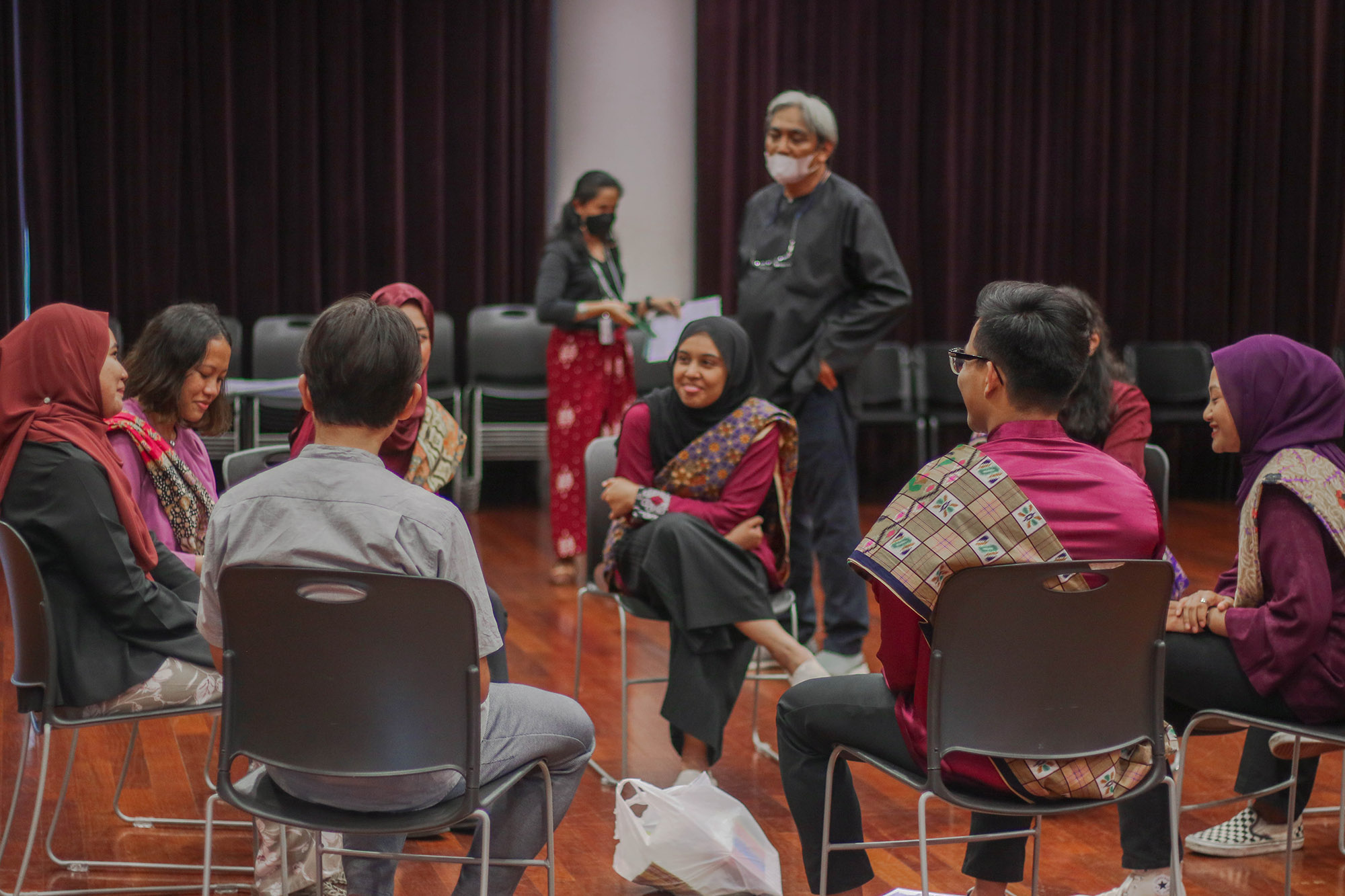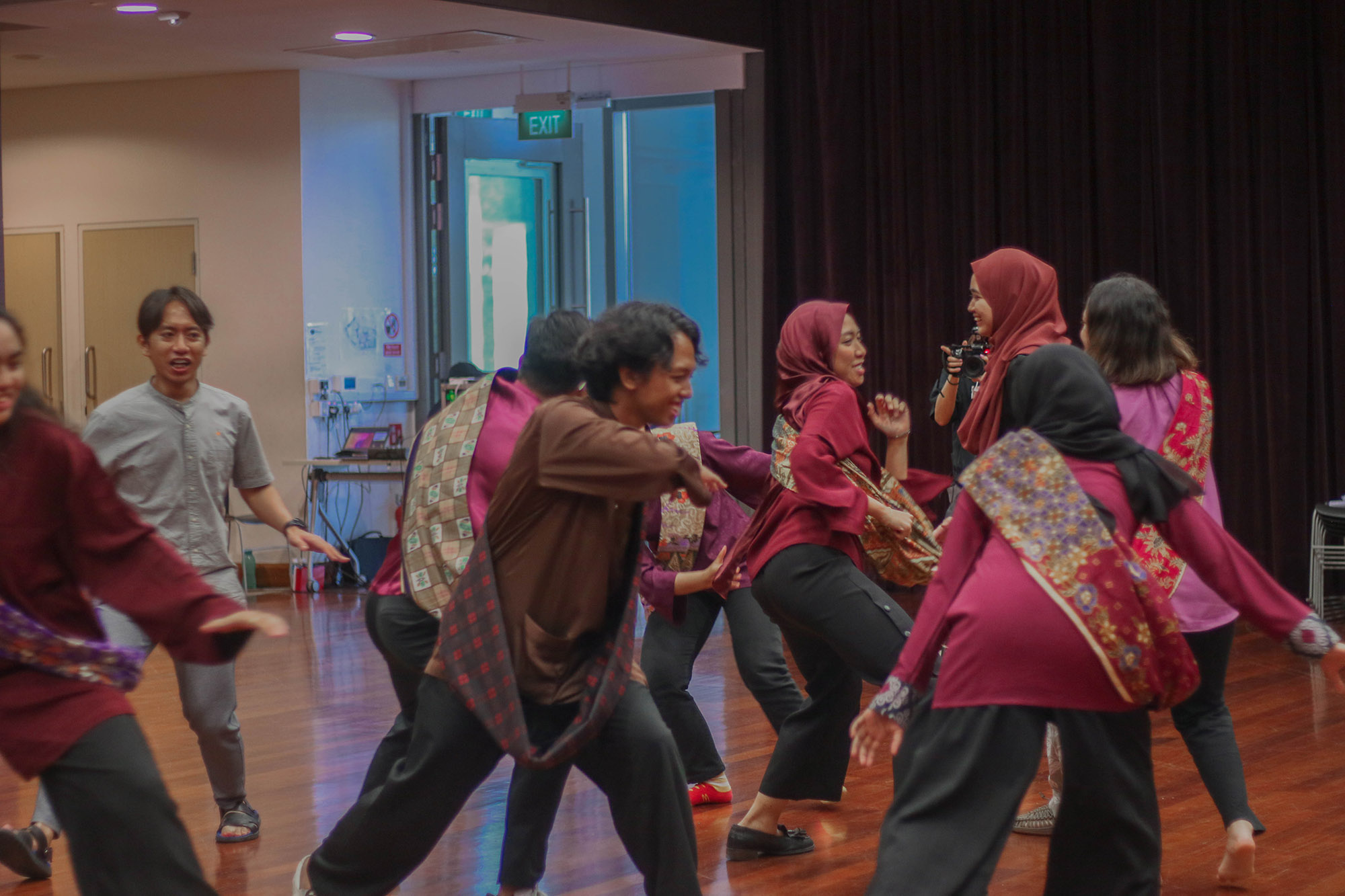Our Love for Malay Dance – Beyond the School Setting
By Nur Zakirah Binte Rosman (2023)
Can we still dance upon graduating school? What can we do to expose others to Malay dance? How can we contribute to the Malay dance scene?

On the first afternoon of the symposium, we held an interactive session with participants of various backgrounds. The programme line-up included a self-introduction, icebreaker games to allow the participants to get comfortable, and lastly, a discussion session. Through interaction with the participants, we had hoped to hear their experiences and concerns pertaining to Malay dance as well as their aspirations.
“Hi, my name is…”

For the interactive session, members of NUS Ilsa Tari and the participants were randomly assigned into two groups. To start off, members of each group introduced themselves. I enjoyed getting to know the participants’ unique experiences and backgrounds. For instance, one of the participants is currently an undergraduate in NTU-NIE and is an aspiring Malay language teacher. Another participant is a Malaysian residing in Singapore, and is working as a nurse. While the former is currently practising Malay dance in her university, the latter has stopped dancing although he has a deep interest and love for Malay dance. I found that most of us have been involved in Malay dance since we were in primary or secondary schools, although I also acknowledge that there are a few who only started dancing upon entering university.
Let’s Play!
Afterwards, we played a game of charades whereby each group member is given a word related to Malay dance which they would have to act out for others to guess. In the group that I was in, most of us acted out words relating to the typical props used in the Malay dance such as bakul (basket), kain (cloth), kipas (fan) and many more!

I felt that this game tested our knowledge about Malay dance. It was comforting to observe that we are aware of the common types of props used in Malay dance, as we relate them to our prior observations as dancers or audience. Notably, these objects are not merely props – but they are tools and/or cultural objects that carry the symbols and values of the people of the Alam Melayu (Malay world). This commonality is made salient through our interactions with the Malaysian participant. It was interesting to observe that such markers of Malay culture are brought over to Malay dance, and how the artform shares similarities across territorial boundaries.
Experiences, Concerns and Hopes
As we became acquainted with one another and started to feel more comfortable, we then moved on to the discussion session, where we listened to every participant’s experiences with Malay dance. The undergraduate from NTU-NIE had shared her unforgettable experience teaching Malay dance to her students. As part of her teaching stint with a local school, the school had organised Malay dance sessions where the students will learn via a video tutorial. In one of those sessions however, the video could not be played. Hence, she took the opportunity to carry on with the session and to teach them instead. Here, most of the students has asked her:
“What is Malay Dance, Cikgu?”
The question made her realise that the younger generation’s knowledge and exposure towards the Malay dance (and culture) is limited. In fact, she feels that it boils down to the parents to educate the children and expose themselves to Malay dance as ultimately parents are their “first teachers” in life. However, such a realisation made her feel more motivated and responsible to educate her students about not only Malay dance, but also the Malay culture in general. She feels that it is her responsibility to “melestarikan” (promote) Malay dance.
On the other hand, the Malaysian participant has been involved in Malay dance since he was in primary school up until university. However, residing in Singapore, there were very limited platforms for him to practise Malay dance for leisure purposes. This is due to his inability to commit to the frequent training dates given his occupation as a nurse. Hence, despite longing to dance and his love for it, his involvement with Malay dance is limited to him being part of the audience. He wishes for more opportunities to practise Malay dance in Singapore, such as an increase in open classes and for it to be accessible for individuals like him who may not be familiar with the Malay dance culture here.

It is interesting to observe that the sentiments from the participants are similar to the conversations surfaced from the GERAK Pre-Symposium that we have had with the invited practitioners. In both sessions, there is an active questioning on the future of Malay dance and the sites for Malay dance. Youth dancers and young practitioners alike, are aware of the responsibility of parents and schools in exposing young students to Malay dance, and by extension the Malay culture. There is also an inclination towards providing space for dance as leisure for those who enjoy it. Apart from schools as a site for Malay dance, there is a potential for open classes to be offered to those who do not have time to commit as members of professional dance groups. While some of the young practitioners have started pilot programmes, the reach for these open classes has been limited. Yet, through the interactive session, we discovered that there is an actual demand among dancers, and therefore, these open classes should be promoted.
I would also like to highlight two other participants who shared similar experiences to one another. While one of them had shared how she feels excitement in being able to express herself through Malay dance, the other is no longer actively dancing upon graduating from university. However, both of the participants share the same concerns pertaining to the continuation of dancing which can be attributed to their concerns of being a veiled female. The former had yet to ask her parents if she could continue partaking in Malay dance after graduation due to the fear that her parents may prohibit her. On the other hand, the latter is no longer actively dancing as her parents had forbidden her from doing so. For both the participants, such concern or experience can be attributed to the existing sentiment of:
“It is inappropriate for a veiled girl to dance in front of men”
I gathered that such sentiments, among close peers and family members, act as barriers that prevent student-dancers from pursuing Malay dance, be it as leisure, or for staged performances. One of them even claims that if possible, she does not want to lose her involvement in Malay dance as:
“Being on stage, enables me to just focus on performing as I forget about reality”


Regardless, both the participants stated that they respect their parents’ decisions in spite of their love for Malay dance. Even though it may sadden them that they may not be able to be involved in Malay dance as a dancer, they claimed that they will try their best to be involved in any way possible such as being part of the GERAK Symposium. It is also interesting to note how contrary to the belief that Malay dance outfits may be revealing for women, I feel that Malay dance costumes these days are becoming more mindful and respectful towards the religion. Hence, such claims on the perceived inappropriateness of dancing veiled women highlight the different standpoints of permissibility and moral/religious policing in the society. Through the sharing, we are made aware of how Malay dance is being perceived by certain fractions within the Malay community today.
Final Thoughts
In relation to the discussion segment above, our guest speaker, Dr Noramin Farid who had observed the discussion, stated how he noticed a sense of restriction but at the same time a desire to seek a resolution towards their concerns. He also acknowledged how hijab wearers may encounter the stigma that they should not be dancing in front of other men. At the same time, the hijab posed an added responsibility and a set of expectations on the veiled women. Following which, he also surfaced the notion of heritage. Here, Dr Noramin questioned how the younger generation can enable their parents to understand what they do (in practising the culture), when their parents are not pushing them to better understand the Malay culture in the first place.

This sharing was observed and moderated by Dr Noramin Farid, Mr Osman Abdul Hamid and Ms Melissa Quek.
While we hoped to have had more participants in the interactive session, I felt that having the chance to listen to various kinds of concerns among the participants was truly enriching. Not only has it broadened my perspectives on the Malay community’s perceptions towards Malay dance, but the participants’ concerns have also highlighted some of the limitations in the Malay dance scene – which may otherwise have not crossed my mind. That being said, their optimism towards the Malay dance scene can be seen from their hopes and desires to continue to involve themselves in Malay dance through any means possible (as an audience or as a performer), which has truly inspired me as well! As a Malay dancer myself, I aspire to continue doing my best so that I can provide other individuals with the outlet to continue developing their love for Malay dance.
Previous Article:
“What does Malay Dance Mean To Me?” – Questions and Concerns of Malay Dance Practitioners Today







